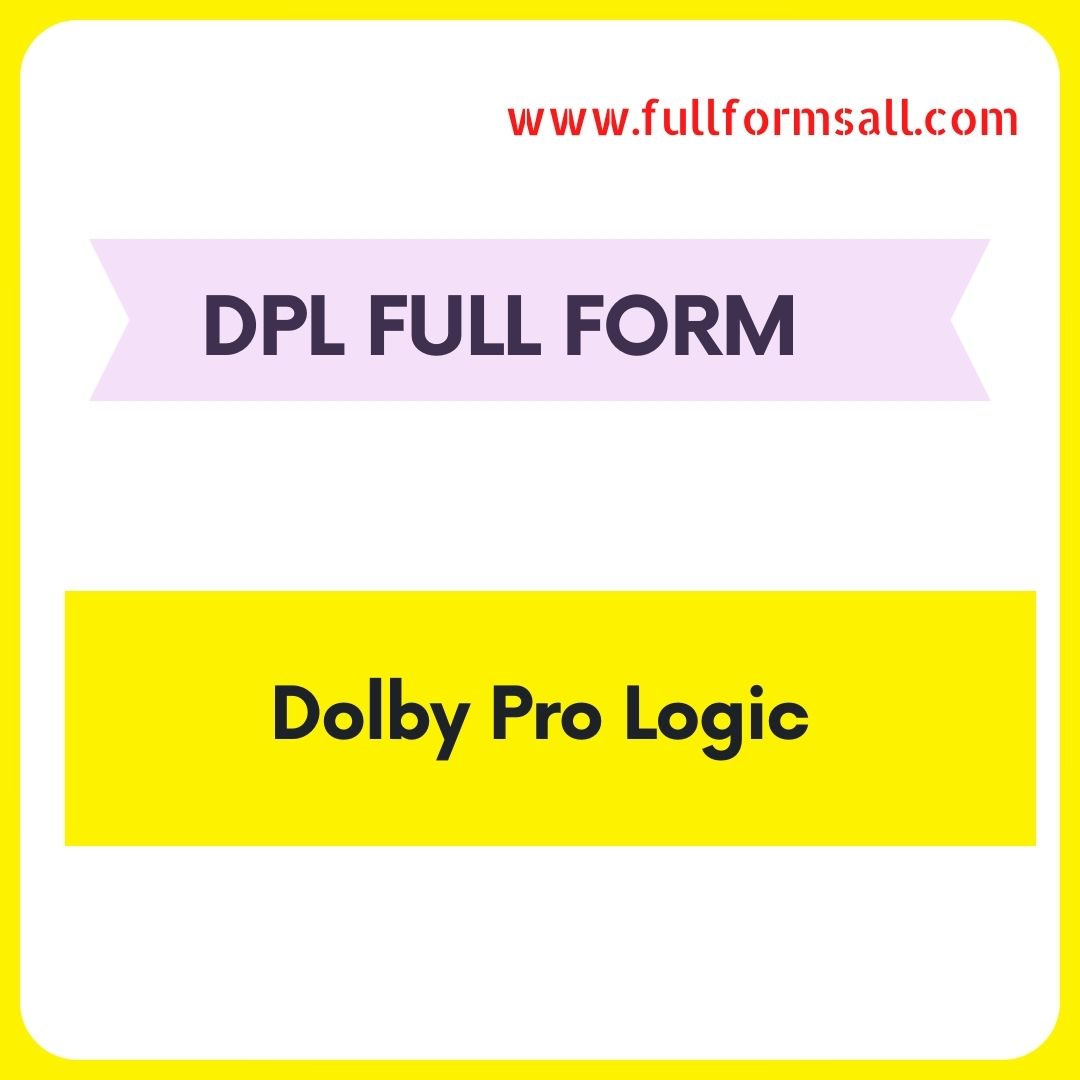In this article you get to know about DPL full from and other different abbreviations of DPL in various fields. DPL full form refers to Dolby Pro Logic.
Dolby Pro Logic is a surround sound technology developed by Dolby Laboratories. It was introduced in 1987 as an improvement over the earlier Dolby Surround system. Dolby Pro Logic is designed to decode and reproduce multi-channel audio from stereo or matrix-encoded sources. The system is based on a four-channel setup, consisting of front left, front right, center, and mono rear channels. The rear channel is derived from the stereo signal using matrix encoding techniques. Dolby Pro Logic uses a matrix decoder to extract the surround information from the encoded signal during playback.
The decoding process of Dolby Pro Logic involves extracting the center channel audio and spreading it evenly between the front left and right speakers. The rear channel audio is also extracted and played through a single rear speaker or split between two rear speakers. Dolby Pro Logic is widely used in various applications, including home theater systems, televisions, and video game consoles. It provides a more immersive audio experience compared to traditional stereo sound by creating a sense of surround sound, even with just two front speakers and one or two rear speakers.
Dolby Pro Logic was a significant advancement in audio technology when it was introduced. It allowed viewers to experience a more immersive soundstage and spatial dimensionality in their home entertainment systems without requiring dedicated surround sound speakers. The system became popular during the era of VHS tapes and early DVD releases, as many movies and TV shows were mixed in Dolby Surround format. It’s important to note that Dolby Pro Logic is an older technology and has been succeeded by newer and more advanced audio formats such as Dolby Digital, Dolby TrueHD, and Dolby Atmos, which offer higher audio quality and more precise sound positioning.
One of the key features of Dolby Pro Logic is its ability to extract surround sound information from stereo sources. This means that even if a movie or music recording is not specifically encoded in a multi-channel format, Dolby Pro Logic can still create a surround sound effect by intelligently decoding and distributing the audio across the available speakers. This feature greatly expanded the range of content that could benefit from a surround sound setup.
Dolby Pro Logic also incorporates a dialog normalization feature. This feature ensures that dialogue remains clear and intelligible even when other audio elements, such as music or sound effects, are louder. It helps to maintain a consistent volume level for dialogue, enhancing the overall listening experience.
Dolby Laboratories introduced various iterations and enhancements to the Pro Logic system. This included Dolby Pro Logic II, which provided improved decoding and expanded the system to support up to 7.1 surround sound configurations. Dolby Pro Logic IIx and IIz further extended the system to include additional height channels for a more enveloping audio experience. While Dolby Pro Logic has been surpassed by newer audio technologies, it still holds nostalgic value for many audio enthusiasts and can be found in older audio systems and vintage home theaters. It played a significant role in popularizing the concept of surround sound and paved the way for the development of more advanced formats like Dolby Digital and Dolby Atmos, which offer even greater immersion and precision in sound reproduction.
Features about Dolby Pro Logic:
Cinema Applications: Dolby Pro Logic was not only used in home entertainment systems but also found its way into movie theaters. Many cinemas installed Dolby Pro Logic systems to provide a surround sound experience to their audiences. This allowed moviegoers to enjoy a more immersive audio experience even in theaters that didn’t have dedicated surround sound speaker setups.
Music Playback: While Dolby Pro Logic was primarily designed for movie soundtracks, it could also enhance the playback of music recordings. By decoding stereo music sources using the matrix encoding and decoding techniques, Dolby Pro Logic expanded the soundstage and created a sense of depth and spatiality in the music playback.
Game Consoles: Dolby Pro Logic was widely adopted by video game console manufacturers to deliver a more immersive audio experience in gaming. It allowed gamers to hear positional audio cues, such as footsteps or gunfire, coming from different directions, enhancing gameplay and immersion. Many popular game titles of the time were mixed in Dolby Pro Logic to take advantage of its surround sound capabilities.
Surround Sound Modes: Dolby Pro Logic offered different listening modes to cater to various preferences and content types. These modes included “Music Mode” for stereo music playback, “Movie Mode” for decoding movie soundtracks, and “Game Mode” for an optimized audio experience in gaming. Users could select the appropriate mode based on the content they were consuming to achieve the desired audio output.
Legacy Support: Even though Dolby Pro Logic has been largely replaced by newer audio formats, many devices and systems still include Dolby Pro Logic compatibility for backward compatibility. This allows users to enjoy older content that was encoded in Dolby Surround or Pro Logic format without losing the surround sound experience.
Different abbreviations of DPL in various fields are as follows
| Term | Abbreviation | Category |
| DPL | Dolby Pro Logic | Business |
| DPL | Dominion Petroleum Limited | Business |
| DPL | Diagnostic Peritoneal Lavage | Medical |
| DPL | Days Post Lesion | Medical |
| DPL | Direct Patient Logistics | Medical |
| DPL | Digital Power Line | Computing |
| DPL | Dual Propagation Log | Computing |
| DPL | Descriptor Privilege Level | Computing |
| DPL | Digital Production Library | Computing |
CONCLUSION:
Dear reader in this article you get to know about DPL full from and DPL term used in various other fields, If you have any query regarding this article kindly comment below.

